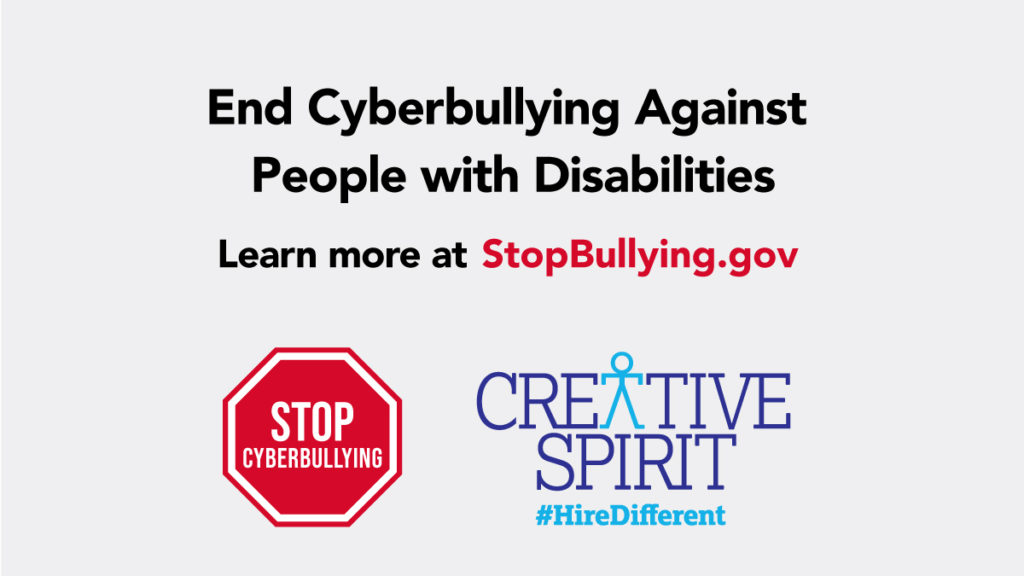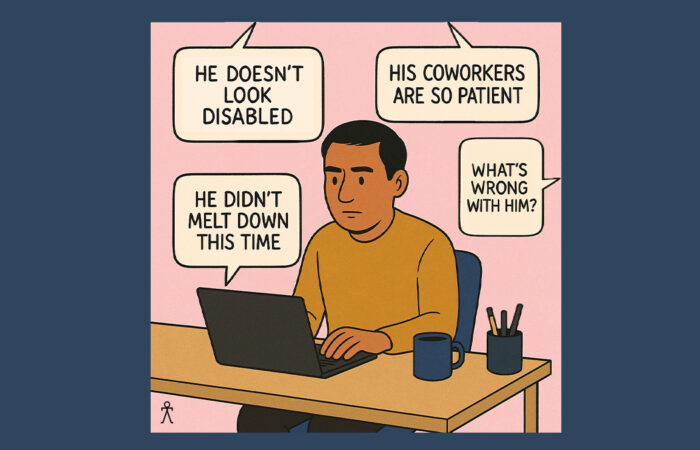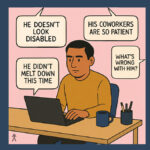By Menachem Rephun, Communications Manager Creative Spirit and Self Advocate

Since the start of the new Millenium, the internet has taken on an ever-more important role in everyday life. Millions of people worldwide utilize the internet on a daily basis for work, entertainment, social interaction, and access to important information. For the disabilities community, the increasing importance of the internet has been a mixed blessing. While creating exciting new opportunities for job searching, social connection, professional networking, and improved access to vital supports and services, a disturbing and dangerous trend has also emerged: cyberbullying. As its name suggests, this form of harassment takes place via digital devices like computers, cell phones, and tablets, and can occur in social media, forums, or gaming that allows participants to view and/or share content. Roughly 16% of students in grades 9-12 have reported being cyberbullied, according to the 2019 School Crime Supplement to the National Crime Victimization Survey. StopBullying.gov, an online anti-bullying resource, explains that cyberbullying is unique in its persistence, permanence, and subtlety, due to the fact that teachers and parents can’t overhear it or see it taking place. Although cyberbullying dates back to the early days of the internet in the 1990s, the emergence of social media has made it an even more serious problem.
Teens and children with disabilities are at especially high risk for cyberbullying, due to physical, intellectual, and/or social skills differences. In targeting one of the most vulnerable demographics in our society, cyberbullying represents a clear and present danger. This was confirmed by a 2019 report by the Ruderman Family Foundation, which found that, out of over 20,000 students with and without disabilities, those with disabilities are almost twice as likely to experience cyberbullying as their peers. Dr. Miriam Heyman, a co-author of the study, said she found the results “shocking.” According to the disability rights blog The Mighty, Heyman said the study’s findings are “a stark reminder of the fact [that] we’re failing, as kids with disabilities are cyberbullied at twice the rate of kids without them.” This study, and the persistence of cyberbullying, leaves no doubt that this is a problem parents, legislators, and educators ignore at their own peril, as the immediate and long-term impact of cyberbullying on the self-esteem of teens and children with disabilities can be devastating. Heyman’s study found a direct correlation between cyberbullying and mental health issues in students with disabilities, with 45% experiencing depression due to the cyberbullying they experienced, compared to 31% of non-disabled students. Nevertheless, the study also found that the internet does provide a positive outlet for students with disabilities to socially connect. 38% identified the internet as an important source of support, compared with 28% of non-disabled students.
The ongoing crisis of cyberbullying raises the question of what practical steps can be taken to put a stop to it. Thankfully, some measures have been adopted at the State level to resolve this crisis, with many States including cyberbullying in laws requiring schools to take action. StopBullying.Gov recommends several strategies as well. These include creating a “buddy system” for students with special needs; implementing social-emotional learning activities; providing peers with up-front information on the kinds of support needed by students with special needs, and having adults facilitate that support; and conducting team-based learning activities. For parents, teachers, or classmates who suspect that a child may be a victim of cyberbullying, StopBullying suggests keeping a record of what’s happening, reporting the cyberbullying to the school, and intervening by reaching out to the child or posting positive comments about the person that can shift the conversation in a more positive direction. The Ruderman Family Foundation’s proposed solution involves encouraging kindness through a social media profile badge for accounts that consistently treat others compassionately, and encouraging adolescents to use the hashtag #bullyfree to signify that there’s no bullying in their content. For parents, Understood.org recommends reassuring their child that they love and support them, encouraging them to take breaks from the computer, speaking with the parents of the child committing the cyberbullying (if they can be identified), and empowering one’s child with specific steps they can take. A 2016 study by the Cyberbullying Research Center found that many teens are hesitant to report cyberbullying out of fear that doing so will only make the bullying worse and that nothing will be done about it anyway. The authors of the study note that “The absolute key to getting students to report bullying is to improve responses…Stopping bullying might involve discipline, but it doesn’t have to. It could be as simple as communicating to the one doing the bullying that their behaviors are wrong, hurtful, and unacceptable.”
Protecting children and teens with disabilities from cyberbullying, which can inflict long-lasting emotional trauma, is absolutely essential, especially for a society that purports to value inclusion, diversity, and acceptance, and the onus to take action falls not only on parents, educators, legislators, caregivers, but on all of us. As Russell Lehmann, a motivational speaker with autism who has experienced cyberbullying, eloquently put it, according to The Mighty: “We all deserve to be ourselves because a huge peace of mind comes with that. And cyberbullying is getting in the way of that and causing a lot of harm on top of it.” Creative Spirit’s mission is to ensure that people with disabilities, of all ages and backgrounds, are able to enjoy that peace of mind, and are protected against all forms of discrimination and harassment. If you’re a parent, caregiver, educator, or friend with reason to believe that cyberbullying is taking place, we urge you to take immediate action. Cyberbullying (or any other form of bullying) has no place in an equitable and inclusive society, where people of all abilities should feel safe, secure, and comfortable with who they are. By being vigilant and taking or encouraging action against bullying, we can make a difference and ensure that cyberbullying becomes a thing of the past.






